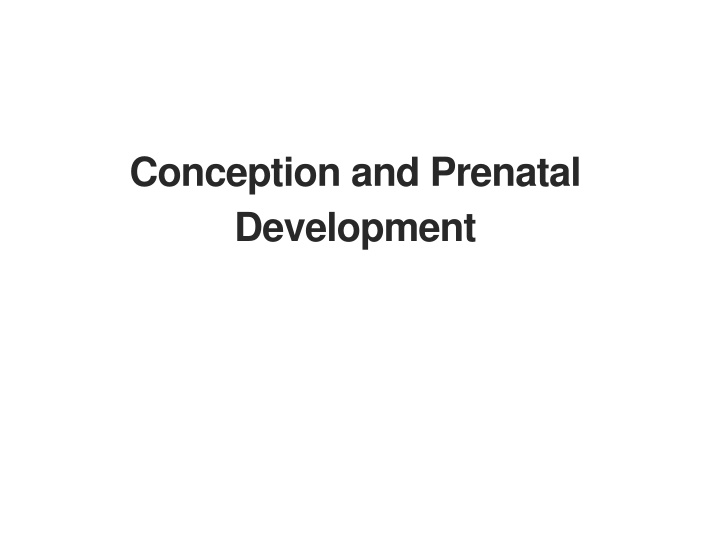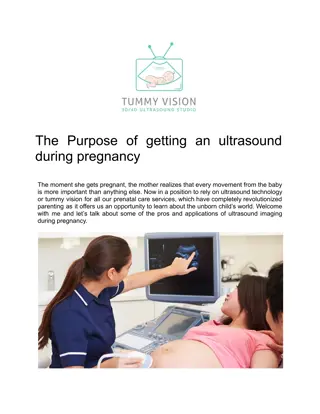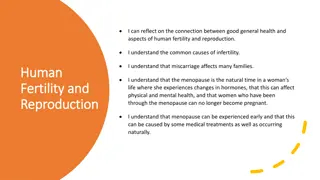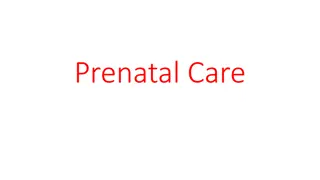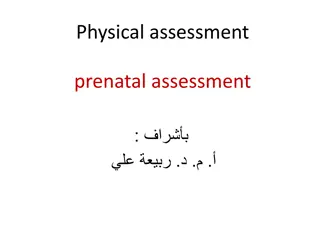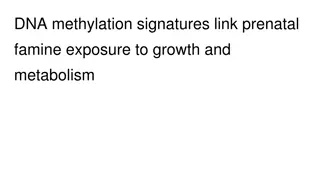Conception and Prenatal Development Process
The process of conception and prenatal development involves the union of sperm and ovum, formation of blastocyst, development of amniotic sac and placenta, and growth of the embryo with distinct germ layers. The trophoblast cells play a crucial role in placental formation, while the embryo undergoes significant structural changes in the early stages of development.
Download Presentation

Please find below an Image/Link to download the presentation.
The content on the website is provided AS IS for your information and personal use only. It may not be sold, licensed, or shared on other websites without obtaining consent from the author.If you encounter any issues during the download, it is possible that the publisher has removed the file from their server.
You are allowed to download the files provided on this website for personal or commercial use, subject to the condition that they are used lawfully. All files are the property of their respective owners.
The content on the website is provided AS IS for your information and personal use only. It may not be sold, licensed, or shared on other websites without obtaining consent from the author.
E N D
Presentation Transcript
Conception and Prenatal Development
For conception (fertilization), a live sperm must unite with an ovum in a fallopian tube with normally functioning epithelium. Conception occurs just after ovulation, about 14 days after a menstrual period. At ovulation, cervical mucus becomes less viscid, facilitating rapid movement of sperm to the ovum, usually near the fimbriated end of the tube. Sperm may remain alive in the vagina for about 3 days after intercourse. The fertilized egg (zygote) divides repeatedly as it travels to the implantation site in the endometrium (usually near the fundus). By the time of implantation, the zygote has become a layer of cells around a cavity, called a blastocyst. The blastocyst wall is 1 cell thick except for the embryonic pole, which is 3 or 4 cells thick. The embryonic pole, which becomes the embryo, implants first. About 6 days after fertilization, the blastocyst implants in the uterine lining.
Amniotic sac and placenta Within 1 or 2 days of implantation, a layer of cells (trophoblast cells) develops around the blastocyst. The progenitor villous trophoblast cell, the stem cell of the placenta, develops along 2 cell lines: Nonproliferative extravillous trophoblast: These cells penetrate the endometrium, facilitating implantation and anchoring of the placenta. Syncytiotrophoblast: These cells produce chorionic gonadotropin by day 10 and other trophic hormones shortly thereafter. An inner layer (amnion) and outer layer (chorion) of membranes develop from the trophoblast; these membranes form the amniotic sac, which contains the conceptus (term used for derivatives of the zygote at any stage see figure Placenta and embryo at about 11 4/7 weeks gestation). When the sac is formed and the blastocyst cavity closes (by about 10 days), the conceptus is considered an embryo. The amniotic sac fills with fluid and expands with the growing embryo, filling the endometrial cavity by about 12 weeks after conception; then, the amniotic sac is the only cavity remaining in the uterus.
Placenta and embryo at about 11 4/7 weeks gestation The embryo measures 4.2 cm.
Trophoblast cells develop into cells that form the placenta. The extravillous trophoblast forms villi, which penetrate the uterus. The syncytiotrophoblast covers the villi. The syncytiotrophoblast synthesizes trophic hormones and provides arterial and venous exchange between the circulation of the conceptus and that of the mother. The placenta is fully formed by week 18 to 20 but continues to grow, weighing about 500 g by term.
Embryo Around day 10, 3 germ layers (ectoderm, mesoderm, endoderm) are usually distinct in the embryo. Then the primitive streak, which becomes the neural tube, begins to develop. Around day 16, the cephalad portion of the mesoderm thickens, forming a central channel that develops into the heart and great vessels. The heart begins to pump plasma around day 20, and on the next day, fetal red blood cells (RBCs), which are immature and nucleated, appear. Fetal RBCs are soon replaced by mature RBCs, and blood vessels develop throughout the embryo. Eventually, the umbilical artery and vein develop, connecting the embryonic vessels with the placenta. Most organs form between 21 and 57 days after fertilization (between 5 and 10 weeks gestation); however, the central nervous system continues to develop throughout pregnancy. Susceptibility to malformations induced by teratogens is highest when organs are forming.
Physiology of Pregnancy The earliest sign of pregnancy and the reason most pregnant women initially see a physician is missing a menstrual period. For sexually active women who are of reproductive age and have regular periods, a period that is 1 week late is presumptive evidence of pregnancy. Pregnancy is considered to last 266 days from the time of conception 280 days from the first day of the last menstrual period if periods occur regularly every 28 days Delivery date is estimated based on the last menstrual period. Delivery up to 2 weeks earlier or later than the estimated date is normal. Delivery before 37 weeks gestation is considered preterm; delivery after 42 weeks gestation is considered postterm.
Physiology of Pregnancy Pregnancy causes physiologic changes in all maternal organ systems; most return to normal after delivery. In general, the changes are more dramatic in multifetal than in single pregnancies. Cardiovascular Cardiac output (CO) increases 30 to 50%, beginning by 6 weeks gestation and peaking between 16 and 28 weeks (usually at about 24 weeks). It remains near peak levels until after 30 weeks. Then, CO becomes sensitive to body position. Positions that cause the enlarging uterus to obstruct the vena cava the most (eg, the recumbent position) cause CO to decrease the most. On average, CO usually decreases slightly from 30 weeks until labor begins. During labor, CO increases another 30%. After delivery, the uterus contracts, and CO drops rapidly to about 15 to 25% above normal, then gradually decreases (mostly over the next 3 to 4 weeks) until it reaches the prepregnancy level at about 6 weeks postpartum.
The increase in CO during pregnancy is due mainly to demands of the uteroplacental circulation; volume of the uteroplacental circulation increases markedly, and circulation within the intervillous space acts partly as an arteriovenous shunt. As the placenta and fetus develop, blood flow to the uterus must increase to about 1 L/min (20% of normal CO) at term. Increased needs of the skin (to regulate temperature) and kidneys (to excrete fetal wastes) account for some of the increased CO. To increase CO, heart rate increases from the normal 70 to as high as 90 beats/min, and stroke volume increases. During the 2nd trimester, blood pressure (BP) usually drops (and pulse pressure widens), even though CO and renin and angiotensin levels increase, because uteroplacental circulation expands (the placental intervillous space develops) and systemic vascular resistance decreases. Resistance decreases because blood viscosity and sensitivity to angiotensin decrease. During the 3rd trimester, BP may return to normal. With twins, CO increases more and diastolic BP is lower at 20 weeks than with a single fetus.
Exercise increases CO, heart rate, oxygen consumption, and respiratory volume/min more during pregnancy than at other times. The hyperdynamic circulation of pregnancy increases frequency of functional murmurs and accentuates heart sounds. X-ray or ECG may show the heart displaced into a horizontal position, rotating to the left, with increased transverse diameter. Premature atrial and ventricular beats are common during pregnancy. All these changes are normal and should not be erroneously diagnosed as a heart disorder; they can usually be managed with reassurance alone. However, paroxysms of atrial tachycardia occur more frequently in pregnant women and may require prophylactic digitalization or other antiarrhythmic drugs. Pregnancy does not affect the indications for or safety of cardioversion.
Hematologic Total blood volume increases proportionally with cardiac output, but the increase in plasma volume is greater (close to 50%, usually by about 1600 mL for a total of 5200 mL) than that in red blood cell (RBC) mass (about 25%); thus, hemoglobin (Hb) is lowered by dilution, from about 13.3 to 12.1 g/dL. This dilutional anemia decreases blood viscosity. With twins, total maternal blood volume increases more (closer to 60%). White blood cell count (WBC) count increases slightly to 9,000 to 12,000/mcL. Marked leukocytosis ( 20,000/mcL) occurs during labor and the first few days postpartum. Iron requirements increase by a total of about 1 g during the entire pregnancy and are higher during the 2nd half of pregnancy 6 to 7 mg/day. The fetus and placenta use about 300 mg of iron, and the increased maternal RBC mass requires an additional 500 mg. Excretion accounts for 200 mg. Iron supplements are needed to prevent a further decrease in Hb levels because the amount absorbed from the diet and recruited from iron stores (average total of 300 to 500 mg) is usually insufficient to meet the demands of pregnancy.
Urinary Changes in renal function roughly parallel those in cardiac function. Glomerular filtration rate (GFR) increases 30 to 50%, peaks between 16 and 24 weeks gestation, and remains at that level until nearly term, when it may decrease slightly because uterine pressure on the vena cava often causes venous stasis in the lower extremities. Renal plasma flow increases in proportion to GFR. As a result, blood urea nitrogen (BUN) decreases, usually to < 10 mg/dL, and creatinine levels decrease proportionally to 0.5 to 0.7 mg/dL .Marked dilation of the ureters (hydroureter) is caused by hormonal influences (predominantly progesterone) and by backup due to pressure from the enlarged uterus on the ureters, which can also cause hydronephrosis. Postpartum, the urinary collecting system may take as long as 12 weeks to return to normal. Postural changes affect renal function more during pregnancy than at other times; ie, the supine position increases renal function more, and upright positions decrease renal function more. Renal function also markedly increases in the lateral position, particularly when lying on the left side; this position relieves the pressure that the enlarged uterus puts on the great vessels when pregnant women are supine. This positional increase in renal function is one reason pregnant women need to urinate frequently when trying to sleep.
Respiratory Lung function changes partly because progesterone increases and partly because the enlarging uterus interferes with lung expansion. Progesterone signals the brain to lower carbon dioxide (CO2) levels. To lower CO2 levels, tidal and minute volume and respiratory rate increase, thus increasing plasma pH. Oxygen consumption increases by about 20% to meet the increased metabolic needs of the fetus, placenta, and several maternal organs. Inspiratory and expiratory reserve, residual volume and capacity, and plasma PCO2 decrease. Vital capacity and plasma PCO2 do not change. Thoracic circumference increases by about 10 cm. Considerable hyperemia and edema of the respiratory tract occur. Occasionally, symptomatic nasopharyngeal obstruction and nasal stuffiness occur, eustachian tubes are transiently blocked, and tone and quality of voice change. Mild dyspnea during exertion is common, and deep respirations are more frequent.
Gastrointestinal (GI) and hepatobiliary As pregnancy progresses, pressure from the enlarging uterus on the rectum and lower portion of the colon may cause constipation. GI motility decreases because elevated progesterone levels relax smooth muscle. Heartburn and belching are common, possibly resulting from delayed gastric emptying and gastroesophageal reflux due to relaxation of the lower esophageal sphincter and diaphragmatic hiatus. Hydrochloric acid production decreases; thus, peptic ulcer disease is uncommon during pregnancy, and preexisting ulcers often become less severe. Incidence of gallbladder disorders increases somewhat. Pregnancy subtly affects hepatic function, especially bile transport. Routine liver function test values are normal, except for alkaline phosphatase levels, which increase progressively during the 3rd trimester and may be 2 to 3 times normal at term; the increase is due to placental production of this enzyme rather than hepatic dysfunction.
Endocrine Pregnancy alters the function of most endocrine glands, partly because the placenta produces hormones and partly because most hormones circulate in protein-bound forms and protein binding increases during pregnancy. The placenta produces the beta subunit of human chorionic gonadotropin (beta-hCG), a trophic hormone that, like follicle-stimulating and luteinizing hormones, maintains the corpus luteum and thereby prevents ovulation. Levels of estrogen and progesterone increase early during pregnancy because beta-hCG stimulates the ovaries to continuously produce them. After 9 to 10 weeks of pregnancy, the placenta itself produces large amounts of estrogen and progesterone to help maintain the pregnancy. The placenta produces a hormone (similar to thyroid-stimulating hormone) that stimulates the thyroid, causing hyperplasia, increased vascularity, and moderate enlargement. Estrogen stimulates hepatocytes, causing increased thyroid-binding globulin levels; thus, although total thyroxine levels may increase, levels of free thyroid hormones remain normal.
Effects of thyroid hormone tend to increase and may resemble hyperthyroidism, with tachycardia, palpitations, excessive perspiration, and emotional instability. However, true hyperthyroidism occurs in only 0.08% of pregnancies. The placenta produces corticotropin-releasing hormone (CRH), which stimulates maternal adrenocorticotropic hormone (ACTH) production. Increased ACTH levels increase levels of adrenal hormones, especially aldosterone and cortisol, and thus contribute to edema. Increased production of corticosteroids and increased placental production of progesterone lead to insulin resistance and an increased need for insulin, as does the stress of pregnancy and possibly the increased level of human placental lactogen. Insulinase, produced by the placenta, may also increase insulin requirements, so that many women with gestational diabetes develop more overt forms of diabetes. The placenta produces melanocyte-stimulating hormone (MSH), which increases skin pigmentation late in pregnancy.
The pituitary gland enlarges by about 135% during pregnancy. The maternal plasma prolactin level increases by 10-fold. Increased prolactin is related to an increase in thyrotropin-releasing hormone production, stimulated by estrogen. The primary function of increased prolactin is to ensure lactation. The level returns to normal postpartum, even in women who breastfeed.
Dermatologic Increased levels of estrogens, progesterone, and MSH contribute to pigmentary changes, although exact pathogenesis is unknown. These changes include Melasma (mask of pregnancy), which is a blotchy, brownish pigment over the forehead and malar eminences Darkening of the mammary areolae, axilla, and genitals Linea nigra, a dark line that appears down the midabdomen Melasma due to pregnancy usually regresses within a year. Incidence of spider angiomas, usually only above the waist, and of thin- walled, dilated capillaries, especially in the lower legs, increases during pregnancy.
Dermatologic Manifestations of Pregnancy 1- Melasma 2- Linea Nigra A linea nigra is a dark line that appears down the midabdomen during pregnancy.
3- Spider Angioma Spider angiomas (nevus araneus) are small, bright red spots that are surrounded by tiny blood vessels (capillaries), which resemble spider legs. After releasing pressure sufficient to blanch them, they refill from the central area. They are normal in many healthy people. They commonly develop in women who are pregnant or use oral contraceptives and in people who have cirrhosis of the liver.
